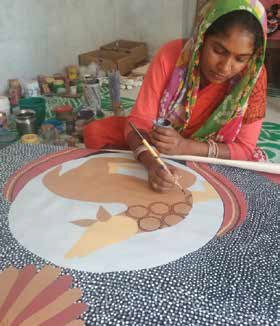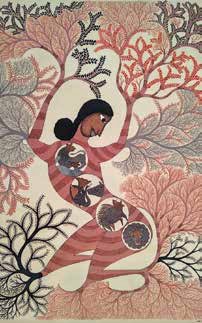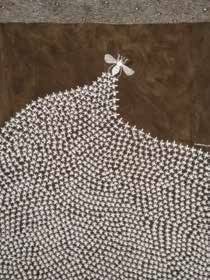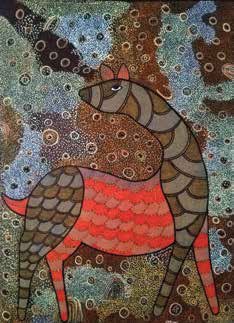
What’s in a Story?
- bey0ndM@gz!ne
- November 6, 2021
- Traditional Art
- 0 Comments
 How the Craft & Community Development Foundation is helping tribal artists weave their own narratives
How the Craft & Community Development Foundation is helping tribal artists weave their own narratives
Throughout history, storytelling has been one of the most defining of human characteristics.
It is by way of stories that we have been able to build the identities of entire nations, families, causes, and ourselves. It is the way of our world and our world’s very way of existence. But for anything to survive, it needs to be cared for.
As we increasingly need to preserve identities and faithfully pass down our heritage, it is our stories that we must thoughtfully consider. Like seeds that need to be resown for the vibrant blossoming of any culture, our stories not only need to be retold but reheard and recelebrated in new contexts. This is a task most fervently undertaken by the Crafts and Community Development Foundation (CCDF) in India.
 Founded by Sundeep Bhandari, CCDF works to champion and revitalize tribal and folk-art communities. They have committed to weaving the indigenous stories of India into the more globalized, modern fabric.
Founded by Sundeep Bhandari, CCDF works to champion and revitalize tribal and folk-art communities. They have committed to weaving the indigenous stories of India into the more globalized, modern fabric.
These rich visual traditions and legacies, passed from one generation to the next, carry the very flavor of our earth. Tribal and folk art rhythmically beat as the heart of the land by capturing the homegrown beliefs and values of traditional communities. These stories form the foundation of India’s cultural heritage.
 They also continue to contribute diverse perspectives as they depict their evolving experiences.
They also continue to contribute diverse perspectives as they depict their evolving experiences.
By funding projects and residency programs that support the livelihoods of artisan communities, CCDF seeks to foster a new generation of tribal art. One that is rooted in tradition and also has a meaningful dialogue with contemporary cultural systems.
Through the ongoing Gondwana Art Project, CCDF celebrates tribal art that emerges from the Gondwana Region in Central India. These include Gond, Warli, Pattachitra, and Bhil art. As a part of this program, the organization provides funding and close mentorship with designers to introduce local artisans to new markets, opportunities, and contemporary collaborations.
 Despite periods of complete lockdown due to the COVID-19 pandemic, the organization remains unwearied and continues to ensure their artisans’ manners of sustained livelihood by equipping them with digital tools to adapt their ways of creating and collaborating remotely. With no signs of slowing down any time soon, CCDF has already put plans in place to further foster creative empowerment and cross-cultural exchange between international artists and local artisans.
Despite periods of complete lockdown due to the COVID-19 pandemic, the organization remains unwearied and continues to ensure their artisans’ manners of sustained livelihood by equipping them with digital tools to adapt their ways of creating and collaborating remotely. With no signs of slowing down any time soon, CCDF has already put plans in place to further foster creative empowerment and cross-cultural exchange between international artists and local artisans.
By providing these artisans the space to experiment and develop their own unique voices, CCDF unleashes the otherwise overlooked creative potential of Indian artisans upon the world and expands the pool of our nation’s storytellers. Groundbreaking in every sense of the word, CCDF’s efforts are rooted in a fierce accessibility, broadening the scope of not only those who tell our stories, but those who hear these stories as well.
I never thought that I would learn about my cultural heritage through Instagram, but that’s exactly where CCDF’s strength lies – in meeting the contemporary world where it is and bringing to life lineages of heritage stories. With simplicity and ingenuity, CCDF demonstrates how traditional craft can be uplifted through modern modes of connection, and spurs within us the realization that what existed in the past doesn’t end with the past but can evolve and thrive within the present. And so, let us write our own collective story. A story of love, pride, and celebration, to support our own, make space for our own, and to exercise our inherent capacity for compassion and appreciation that I know is far greater than we think.
never thought that I would learn about my cultural heritage through Instagram, but that’s exactly where CCDF’s strength lies – in meeting the contemporary world where it is and bringing to life lineages of heritage stories. With simplicity and ingenuity, CCDF demonstrates how traditional craft can be uplifted through modern modes of connection, and spurs within us the realization that what existed in the past doesn’t end with the past but can evolve and thrive within the present. And so, let us write our own collective story. A story of love, pride, and celebration, to support our own, make space for our own, and to exercise our inherent capacity for compassion and appreciation that I know is far greater than we think.
Tribal and folk art rhythmically beat as the heart of the land by capturing the homegrown beliefs and values of traditional communities. These stories form the foundation of India’s cultural heritage.
– By Rhea Khanna




